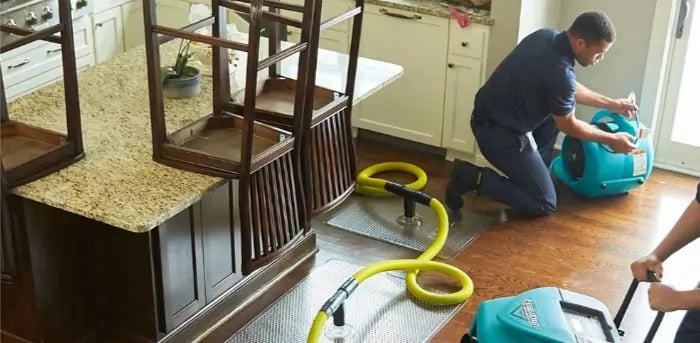Comprehensive Guide to Flood Restoration Techniques: Restoring Homes and Lives
Flood Restoration Techniques
11/28/20233 min read


Introduction:
Floods can wreak havoc on homes, causing extensive damage and leaving behind a trail of destruction. The key to a successful recovery lies in efficient and timely flood restoration techniques. In this comprehensive guide, we'll delve into the intricacies of flood restoration, covering everything from safety precautions to structural repairs.
Section 1: Safety First
Before embarking on any flood restoration project, safety should be the top priority. Taking the right precautions can prevent accidents and health hazards:
1.1 Turning Off Utilities
Begin by turning off electricity and gas to the affected area. Water and electricity are a dangerous combination, and gas leaks can pose serious risks.
1.2 Personal Protective Equipment (PPE)
Always wear appropriate PPE, including gloves, masks, and boots. Floodwaters can be contaminated with bacteria and other harmful substances.
Section 2: Water Extraction
The first step in flood restoration is to eliminate standing water. Effective water extraction prevents further damage and sets the stage for the drying process:
2.1 Pumps and Wet/Dry Vacuums
Utilize industrial-grade pumps and wet/dry vacuums to remove standing water efficiently. Thorough extraction is crucial for preventing structural damage and mold growth.
Section 3: Drying Techniques
Once the water has been extracted, the drying process is initiated to restore normal humidity levels:
3.1 Dehumidifiers
Deploy industrial-grade dehumidifiers to extract moisture from the air. This accelerates the drying process and minimizes the risk of mold growth.
3.2 Air Movers
Use powerful air movers to enhance ventilation. Proper airflow is essential for drying out walls, floors, and other structural elements.
Section 4: Material Removal
Certain materials may be beyond salvaging and need to be removed to prevent further damage:
4.1 Soaked Carpets and Insulation
Discard carpets and insulation that have absorbed excessive water. These materials can harbor mold and compromise indoor air quality.
4.2 Damaged Drywall
Inspect and remove damaged drywall. Wet drywall is a breeding ground for mold, and its removal is crucial for preventing further structural issues.
Section 5: Cleaning and Disinfecting
Thoroughly cleaning and disinfecting surfaces is essential for eliminating bacteria and preventing mold growth:
5.1 Surface Disinfection
Use appropriate disinfectants to clean all surfaces, including walls, floors, and furniture. Pay special attention to areas that came into direct contact with floodwaters.
Section 6: Mold Prevention
Preventing mold growth is a key aspect of flood restoration. Mold can start developing within 24-48 hours after flooding:
6.1 Antimicrobial Treatments
Apply antimicrobial treatments to surfaces to inhibit mold growth. This step is critical for ensuring a healthy indoor environment post-restoration.
Section 7: Inspection and Repairs
Thoroughly inspecting and repairing essential systems is crucial for ensuring the long-term stability of the property:
7.1 Electrical Systems
Have a qualified electrician inspect and repair electrical systems. Water damage can compromise wiring, posing fire hazards.
7.2 HVAC System
Inspect and clean the HVAC system. Floodwater can introduce contaminants that affect air quality if the system is not properly addressed.
Section 8: Structural Repairs
Assessing and repairing structural damage is fundamental to restoring the integrity of the building:
8.1 Wall and Floor Repairs
Evaluate the structural integrity of walls and floors. If damage is detected, undertake necessary repairs or replacements to restore stability.
Section 9: Documenting Damages
Accurate documentation is essential for insurance claims and keeping track of restoration expenses:
9.1 Photographs and Records
Take detailed photographs of the damage before, during, and after restoration. Keep records of all expenses related to repairs and replacements.
Section 10: Professional Assistance
In severe cases, seeking professional help is advisable for a thorough and safe restoration process:
10.1 Restoration Companies
Engage the services of restoration companies with expertise in flood damage. Professionals have the knowledge, equipment, and experience to handle extensive restoration projects.
Conclusion:
Flood restoration is a multifaceted process that demands careful planning and execution. By following these comprehensive flood restoration techniques, homeowners can take significant steps toward recovering from the aftermath of a flood. Remember, safety is paramount, and seeking professional assistance when needed ensures a thorough and effective restoration process. With the right approach, homes can be restored, and lives can return to normalcy after the devastating impact of a flood.
A-Z Dryout
3260 N Hayden Rd STE 210 Scottsdale. Arizona 85251
(480) 617-0978
azdryout@gmail.com
